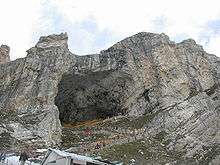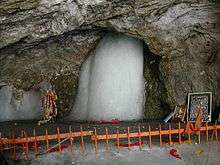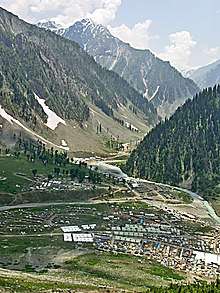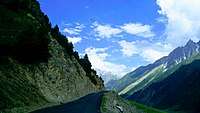Amarnath Temple
Amarnath cave is a Hindu shrine located in Jammu and Kashmir, India. The cave is situated at an altitude of 3,888 m (12,756 ft),[1] about 141 km (88 mi) from Srinagar, the summer capital of Jammu and Kashmir and reached through Pahalgam town. The shrine forms an important part of Hinduism,[2] and is considered to be one of the holiest shrines in Hinduism.[3] The cave is surrounded by snowy mountains. The cave itself is covered with snow most of the year except for a short period of time in summer when it is open for pilgrims. Hundreds of thousands of Hindu devotees make an annual pilgrimage to the Amarnath cave across challenging mountainous terrain.
| Amarnath Cave | |
|---|---|
 Amarnath Cave Temple | |
| Religion | |
| Affiliation | Hinduism |
| District | Anantnag district |
| Deity | Shiva |
| Location | |
| Location | Pahalgam |
| State | Jammu and Kashmir |
| Country | India |
 Shown within Jammu and Kashmir  Amarnath Temple (India) | |
| Geographic coordinates | 34.2149°N 75.5008°E |
| Website | |
| shriamarnathjishrine.com | |
The Amarnath temple is one of 18 Maha Shakti Peethas, or "Grand Shakti Peethas" – highly revered temples throughout South Asia that commemorate the location of fallen body parts of the Hindu deity Sati.
The ShivLinga

Inside the 40 m (130 ft) high Amarnath cave, a stalagmite is formed due to freezing of water drops that fall from the roof of the cave on to the floor and grows up vertically from the cave floor.[4] It is considered to be a Shiva Linga by Hindus. It is mentioned in the ancient Hindu texts of Mahabharata and Puranas that Lingam represents Lord Shiva.[5] The Lingam waxes during May to August, as snow melts in the Himalayas above the cave and the resultant water seeps into the rocks that form the cave and gradually wanes thereafter.[1] As per religious beliefs, it has been claimed that the lingam grows and shrinks with the phases of the moon reaching its height during the summer festival, although there is no scientific evidence for this belief.[6] According to a Hindu religious beliefs, this is the place where Shiva explained the secret of life and eternity to his divine consort, Parvati.[7][8]
History
| Part of a series on |
| Hinduism |
|---|
 |
|
|
Main traditions
|
|
Concepts
|
|
Practices Worship
Arts
Festivals
|
|
Philosophical schools
|
|
Gurus, saints, philosophers
|
|
Texts Scriptures
Other texts
Text classification
|
|
Other topics
|
|
The book Rajatarangini (Book VII v.183) refers to Amareshwara or Amarnath. It is believed that Queen Suryamati in the 11th century AD gifted trishuls, banalingas and other sacred emblems to this temple.[9] Rajavalipataka, begun by Prjayabhatta has detailed references to the pilgrimage to Amarnath Cave. Other than this, there are further references to this pilgrimage in many other ancient texts.
Discovery of Holy Cave
According to legend, Bhrigu Muni was the first to have discovered Amarnath. Long time ago it is believed that The Valley of Kashmir was submerged under water and Kashyap Muni drained it through a series of rivers and rivulets. Therefore, when the waters drained, Bhrigu Muni was the first to have Darshan of Lord Amarnath. Thereafter, when people heard of the Lingam, it became an abode of Lord Bholenath for all believers and a pilgrimage which is done by lakhs of people each year.[9] According to the researchers and as per the belief of locals gadaria community were the first to discover the Amaranth cave and saw the first glimpse of Baba Barfani.
François Bernier, a French physician accompanied Emperor Aurangzeb during his visit to Kashmir in 1663. In his book "Travels in Mughal Empire" he writes while giving an account the places he visited in Kashmir that he was "pursuing journey to a grotto full of wonderful congelations, two days journey from Sangsafed" when he "received intelligence that my Nawab felt very impatient and uneasy on account of my long absence". The "grotto" he refers to is obviously the Amarnath cave as the editor of the second edition of the English translation of the book, Vincient A. Smith makes clear in his introduction. He writes: "The grotto full of wonderful congelations is the Amarnath cave, where blocks of ice, stalagmites formed by dripping water from the roof are worshipped by many Hindus who resort here as images of Shiva….."[10]
Yatra


The peak pilgrimage occurs when the iced stalagmite Shiv lingam reaches the apex of its waxing phase through the summer months.[11] The July-August popular annual Hindu pilgrimage, undertaken by up to 600,000 or more pilgrims to the 130 feet (40 m)-high glacial Amarnath cave shrine of iced stalagmite Shiv linga at 12,756 feet (3,888 m) in the Himalayas, is called Amarnath Yatra.[12][13][14][15] It begins with a 43 kilometres (27 mi) mountainous trek from the Nunwan and Chandanwari base camps at Pahalgam and reaches cave-shrine after night halts at Sheshnag Lake and Panchtarni camps.[16] The yatra is both a way of earning revenue by the state government by imposing tax on pilgrims,[17][18] and making living by the local Shia Muslim Bakarwal-Gujjars by taking a portion of revenue and by offering services to the Hindu pilgrims, and this source of income has been threatened by the Kashmiri militant groups who have harassed and attacked the yatra numerous times,[19][20][21] [22] causing killings and massacres, with at least 59 people killed till July 2017 on this yatra causing death of mostly Hindu pilgrims, at least 10 Muslim civilians, and security forces personnel.[23][24][25][26][27]
The Harkat-ul-Mujahideen group had in the past imposed what it called a "ban" on the yatra in 1994, 1995 and 1998 while threatening the pilgrims of "serious consequences".[28] The Amarnath pilgrimage was suspended in July 2016 due to the Kashmir unrest.[29] A section of Sufis and Shias later demanded resumption of the Yatra. Kalbe Jawad, a Shia cleric and general secretary of Majlis-e-Ulama-e-Hind and Sufi Cleric Syed Hasnain Baqai expressed concern that the tradition had been suspended because of upheaval in Kashmir.[20]
The number of pilgrims to the site has risen from around 12,000 in 1989 to over 400,000 in 2007.[11] This popular yatra destination for Hindus, received about 634,000 people in 2011, the highest recorded number for the site.[30] The number was 622,000 in 2012 and 350,000 in 2013. Pilgrims visit the holy site during the 45-day season around the festival of Shravani Mela in July–August, coinciding with the Hindu holy month of Shraavana.
The beginning of the annual pilgrimage, called Amarnath Yatra[31] is marked by 'pratham pujan' to invoke the blessings of Shri Amarnathji.[32]
In olden days the route was via Rawalpindi (Pakistan) but now a direct train is there connecting rest of India to Jammu, the winter capital of the State. The best part of journey is between Guru Purnima and Shravan Purnima. But the highly unpredictable weather of the mountains should be more obliging before Guru Purnima as rains would not start. There is a bus service from Jammu to Pahalgam (7,500 ft.). At Pahalgam the pilgrims arrange for coolies or ponies to carry gear of food and clothes etc. Pahalgam in Kashmiri means the land of shepherds.
In 2019, the Yatra would commence on 1 July and end on 15 August.[33]
Route
Devotees travel on foot, either from Srinagar or from Pahalgam.[3] The journey from Pahalgam takes about five days.[3]
The State Road Transport Corporation and Private Transport Operators provide the regular services from Jammu to Pahalgam and Baltal. Also privately hired taxis are available from Jammu & Kashmir.
The shorter northern route is just about 16 km long, but has a very steep gradient and is quite difficult to climb. It starts from Baltal and passes through Domel, Barari, and Sangam to reach the cave. The northern route is along the Amarnath valley and all along the route one can see the river Amaravati (a tributary of Chenab) which originates from Amarnath Glacier.
It is believed that Lord Shiva left Nandi, the bull, at Pahalgam (Bail Gaon). At Chandanwari, he released the Moon from his hair (Jata). On the banks of Lake Sheshnag, he released his snakes. At Mahagunas Parvat (Mahaganesh Mountain), he left his son Lord Ganesha. At Panjtarni, Lord Shiva left behind the five elements - Earth, Water, Air, Fire and Sky. As a symbol of sacrificing the earthly world, Lord Shiva performed the Tandava Dance. Then, finally, Lord Shiva entered the Holy Amarnath Cave along with Mata Parvati.[34]
Facilities
En route the cave, various non-governmental organisations have set up food supply and resting tents called pandals which are available for free to the pilgrims. Near the shrine, hundreds of tents which are erected by locals can be hired for a night's stay. Helicopter services from base camp to Panjtarni (6 km from the cave) are also available from various private operators.[35]
Security
Every year, thousands of central armed forces and state police personnel are deployed to provide security to pilgrims from potential terror threats. The forces position at various halts and also in the perimeter of the shrine.[36]
Deaths
Of the 622,000 yatra pilgrims in 2012, 130 died during the yatra. The major cause was attributed to people who were not physically fit for the arduous climb, high elevations, and adverse weather undertook the yatra. Some also died in road accidents before reaching the base camp from where the yatra starts. Of the 130 deaths, 88 were due to purported health reasons and 42 in road accidents. The 2012 pilgrimage ended on Shravana Purnima (Raksha Bandan) Day, 2 August 2012.[37]
Organisers
Officially, the Yatra is organised by the government in collaboration with the Shree Amarnath Shrine Board (SASB). Various agencies provide necessary facilities all along the route during the Yatra period, which includes provision of ponies, supply of power, telecommunication facilities, firewood and setting up of fair price shops.[35]
1990s terrorist threats and 1996 yatra tragedy
The number of pilgrims in 1992 reached 50,000.[38] The first attack against the pilgrims happened in 1993, that year Pakistan-based Harkat-ul-Ansar had announced a ban due to demolition of Babri Masjid. The pilgrimage however passed off mostly peacefully.[39]
In 1994-5 and 1998, the group again announced a ban on the annual Amarnath yatra. In 1996 the militants had assured that they would not interfere allowing a resumed yatra with far greater numbers than in previous years. However, unseasonal blizzards in late August of that year led to a tragedy that claimed the lives of 242 yatris, killed by exhaustion and exposure.[28][22]
2000 pilgrimage massacre
The pilgrimage suffered another setback with the massacre at Nunwan base camp in Pahalgam of at 32 people (including 21 unarmed Hindu pilgrims, 7 unarmed Muslim civilians and 3 security force officers) in a two hour long indiscriminate shoot out by Kashmiri separatists on 2 August 2000.[24][40] Most were yatris on their way to Amarnath[41] or porters and horsemen who would have ferried the pilgrims to the site.[42] This attack on Amarnath yatra was part of the larger 1st and 2nd August 2000 Kashmir massacre in 5 separate coordinated terrorist attacks that killed at least 89 (official count) to 105 people (as reported by PTI), and injured at least 62 more.[24][43] Then Indian Prime Minister Atal Bihari Vajpayee blamed Lashkar-e-Taiba for the killings.[44]
2001 terrorist-attack massacre
On 20 July 2001, a terrorist threw a grenade on a pilgrim night camp at Sheshnag near the Amarnath shrine in which at least 13 persons, including 3 women, were killed in two explosions and firing by militants, 2 were security officials and 3 of the killed person were Muslim civilians.[26][23] 15 other were also injured in the attack.[45]
2002 terrorist-attack massacre
On 30 July and 6 August 2002, in two separate incidents terrorists from al-Mansuriyan, a front group of the Lashkar-e-Taiba, massacred 2 and 9 pilgrims and injured 3 and 27 people in Srinagar and near Nunwan pilgrimage base camp respectively.[24][27]
2017 yatra attack
Seven Hindu pilgrims were killed on 10 July in a gun attack returning from Amarnath. The Pakistani outfit, the Lashkar-e-Taiba, was found responsible.[46]
2019 suspension
The yatra was suspended in August 2019 due to threat of possible terrorist attacks. Similarly, the pilgrimage to Machail Mata has been suspended.[47]
Controversies
2008 Land transfer controversy
On 26 May 2008, the Government of India and the state government of Jammu and Kashmir reached an agreement to transfer 100 acres (0.40 km2) of forest land to the Shri Amarnathji Shrine Board (SASB)[48] to set up temporary shelters and facilities for Hindu pilgrims. Kashmiri separatists opposed the move citing reasons that it will jeopardize the article 370 that gives separate identity to the people of Jammu and Kashmir and prevents any Indian citizen to settle in Kashmir. People in Kashmir staged widespread protests against this decision by government of India.[49] Due to the protests, the J&K State government relented and reversed the decision to transfer land. As a result, Hindus in the Jammu region launched counter-agitations against this roll back.[50]
Environmental impact
Environmentalists have expressed concern that the number of people participating in the Amarnath Yatra is having a negative impact on the area's ecology and some have expressed support for government regulated limits on the number of pilgrims permitted to make the trek.[51] However no studies have been made nor has an environmental impact assessment done. As of date, the Government of India restricts travellers only on the basis on logistics, time window for the yatra and weather.
Amarnath yatra tax controversy
The Government of Jammu and Kashmir had in 2010 issued a notification under the State Motor Vehicle Taxation Act 1957, under which vehicles going to Amarnath Yatra will have to pay a tax of ₹2,000 for seven days and ₹2,000 per day after that. Similar provisions were made for pilgrims going to Sri Mata Vaishno Devi under which they need to pay ₹2000 for a period of three days. India's central political party the Bhartiya Janata Party expressed its ire over imposition of entry fee and accused the then UPA led central government to direct the Jammu and Kashmir dispensation to desist from making attempts to "discriminate" between followers of various religions. BJP criticized the decision "as a reminiscent of Jizya imposed during Mughal period on Hindus," In response to the question in Lok Sabha (Lower house of the Indian Parliament) then Minister of State for Finance, S.S. Palanimanickam clarified that tax is levied on all India Tourist Vehicles entering the state and is therefore not correct to say that Government of Jammu & Kashmir is levying any additional tax on vehicles going to Amarnath and Vaishno Devi. He also said that Taxation of Motor vehicles falls under the purview of State Governments as per the seventh schedule of Constitution of India and Central Government cannot direct the State Government to change the tax rate on vehicles.[52][18]
Popular culture
Famous Santoor artist Rahul Sharma named a track after Amarnath temple as "Shiva Linga: The Amarnath Cave"[53]
Gallery
- Pilgrims riding ponies on the way to Amarnath Cave
- On way to Amarnath Cave
 Pandal tents serving free community kitchen food to the pilgrims
Pandal tents serving free community kitchen food to the pilgrims- Helicopter service up to panjtarni on route to Amarnath Cave
- Tents are available to hire for a small fee near base of imposing Amarnath Cave as visible in background
 Glacier over Lidder River in Chandanwari on the way to Amarnath Temple
Glacier over Lidder River in Chandanwari on the way to Amarnath Temple
See also
- Kanwar Yatra, another popular Hindu pilgrimage.
- List of caves in India
- List of rock cut temples in India
References
- "Amarnathji Yatra - a journey into faith". Official Web Site of Jammu and Kashmir Tourism.
- "New shrine on Amarnath route". The Hindu. Chennai, India. 30 May 2005.
- "The pilgrimage to Amarnath". BBC News. 6 August 2002. Retrieved 5 May 2012.
- "Stalactites and Stalagmites - Cave, Water, Caves, and Growth - JRank Articles". Science.jrank.org. Retrieved 15 April 2013.
- "lingam". Encyclopædia Britannica. 2010.
- Ortner, Jon, "On the road again". PDN Gallery.
- Shantha N. Nair, "The Holy Himalayas", pp.84.
- "Amarnath Cave - The legend". Bhole Bhandari Charitable Trust.
- "Amarnath Yatra: In Search Of Salvation". Shriamarnathyatra.net. Archived from the original on 17 June 2013. Retrieved 15 April 2013.
- Mohini Qasba Raina (2013). Kashur The Kashmiri Speaking People. Partridge Publishing Singapore. p. 327. ISBN 978-1-4828-9945-0.
- Pilgrimage in the Marketplace. Routledge.
- "Amarnath Yatra explained", Amarnath Yatra organisation.
- "Amarnath Yatra Tourism Information", One India Online
- "Amarnath: Journey to the shrine of a Hindu god", Boston.Com Archived 29 March 2016 at the Wayback Machine, 13 July 20112.
- Hiking through the mountains of Kashmir
- "Amarnath yatra ends, least number of pilgrims in decade", The Hindu, 18 August 2016.
- "BJP demands removal of Amarnath yatra entry fee", Times of India.
- "No Additional Tax Levied on Vehicles Going to Amarnath and Vaishno Devi", Press Information Bureau, Ministry of Finance of Government of India, 2010.
- Carl W. Ernst, 2016, "Refractions of Islam in India: Situating Sufism and Yoga", SAGE Publications, ISBN 9351509648.
- "Muslim group asks for reviving Amarnath Yatra", Times of India, 17 July 2016.
- "Expert Speak on Kashmir: No algorithm for Azadi", Observer Research Foundation, August 2016.
- Archived 10 May 2015 at the Wayback Machine
- 6 pilgrims among 13 killed in 2 blasts, The Tribune, 11 July 2017.
- Vicky Nanjappa, "Amarnath yatra has been attacked thrice in the past", One India News. 11 July 2017.
- "Amarnath yatra: Terrorists were directed to eliminate 100 to 150 pilgrims, says intelligence report", The Hindu, 11 July 2017.
- Amarnath terror attack survivor narrates tale of punctured bus tyre and terror strike
- 2003, Chronology of Major Killings in Jammu and Kashmir, Kashmir herald, Volume 2, No. 11.]
- "Rediff On The NeT: Harkatul Mujaheedin 'bans' Amarnath Yatra". Rediff.com. 9 July 1998. Retrieved 15 April 2013.
- Amarnath Yatra Suspended from Jammu Due to Kashmir Situation
- "Amarnath yatra: Record 6.34 lakh visit shrine". Zeenews.india.com. 12 August 2011. Retrieved 15 April 2013.
- "Amarnath yatra likely to start from 29 June", Rediff, 19 June 2011
- "Amarnath yatra's pratham pujan held near Pahalgam", 15 June 2011 23:04 IST, rediff.com
- "Amarnath Yatra 2015 to commence on July 2 and finish on August 29". news.biharprabha.com. 14 April 2015. Retrieved 14 April 2015.
- ShivShankar. "Shiv Shankar's secret of immortality and the Amarnath Cave". ShivShankar.in.
- "Amarnath Yatra 2011- The Countdown Begins | Northern Voices Online". Nvonews.com. 7 June 2011. Archived from the original on 12 May 2013. Retrieved 15 April 2013.
- "High security on Amarnath Yatra routes". Ibnlive.in.com. 29 June 2011. Retrieved 15 April 2013.
- "Amarnath Yatra ends, Charri Mubarak reaches shrine". The Times Of India. 2 August 2012.
- "Further setbacks in Kashmir as militants ban Amarnath yatra, removal of bunkers in Hazratbal". India Today. 31 August 1994. Retrieved 4 August 2018.
- "Why Amarnath Yatra terror attack signals crossing of a red line in Kashmir". Indian Express. 9 July 1998. Retrieved 15 April 2013.
- Amarnath pilgrimage resumes, BBC, 2000-08-04
- Night of massacres leaves 105 dead in valley, The Tribune, 2000-08-03
- Muslim militants kill 21 Hindu pilgrims in Kashmir, The Independent, 2000-08-02
- "Night of massacres leaves 105 dead in valley", The Tribune, 3 August 2000.
- "Prime Minister Vajpayee's statement in Parliament regarding the recent massacre in Jammu & Kashmir". Indianembassy.org. Archived from the original on 4 August 2007. Retrieved 15 April 2013.
- "Amarnath Yatra devotees have faced repeated terror attacks: Here's the blood-soaked history of pilgrimage", First Post, 11 July 2017.
- "Three arrested for attack on Amarnath yatris: IGP Kashmir Munir Khan".
- "Don't Panic, Jammu & Kashmir Governor Tells Political Parties as Tourists and Pilgrims Leave Valley". news18.com. 3 August 2019.
- "Amarnath land row: SASB CEO removed". Zeenews.com. Retrieved 15 April 2013.
- "Jammu is not for burning – 2008 Rediff.com India". Specials.rediff.com. 7 August 2008. Retrieved 15 April 2013.
- Economic blockade affects life in Kashmir (4 August 2008). "Economic blockade affects life in Kashmir". Ndtv.com. Retrieved 15 April 2013.
- "Massive Hindu Pilgrimage Melting Sacred Glacier". News.nationalgeographic.com. 12 March 2012. Retrieved 15 April 2013.
- BJP demands removal of fee imposed on Amarnath yatris, Times of India.
- "Shiva Linga - The Amarnath Cave: Rahul Sharma: Amazon.co.uk: MP3 Downloads". Amazon.co.uk. Retrieved 15 April 2013.
External links
| Wikimedia Commons has media related to Amarnath. |
- Official website
- Amarnath: Journey to the shrine of a Hindu god, Boston Globe news story in pictures, 13 July 2012.
